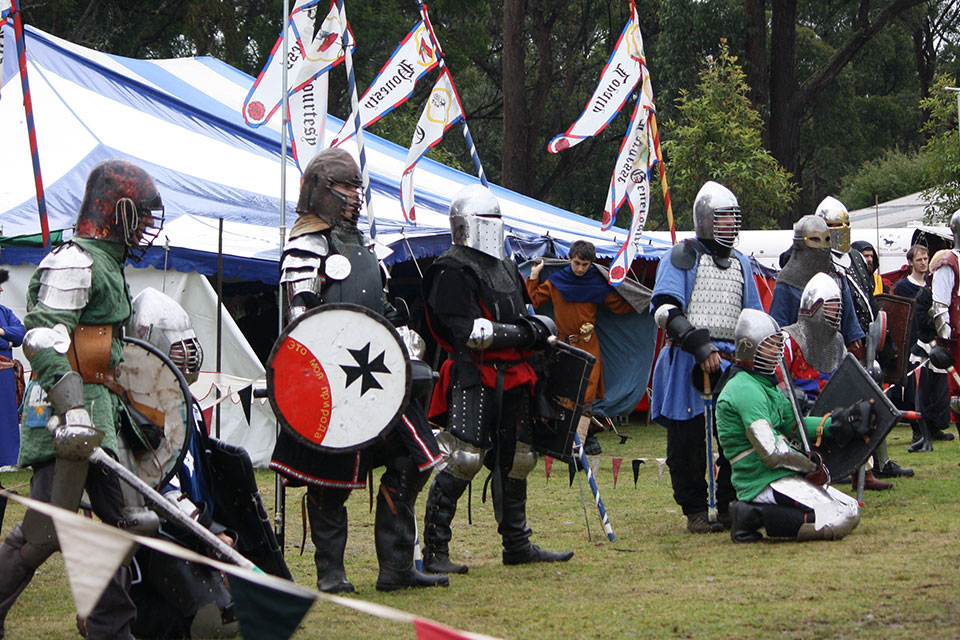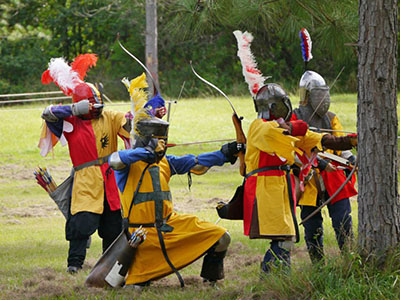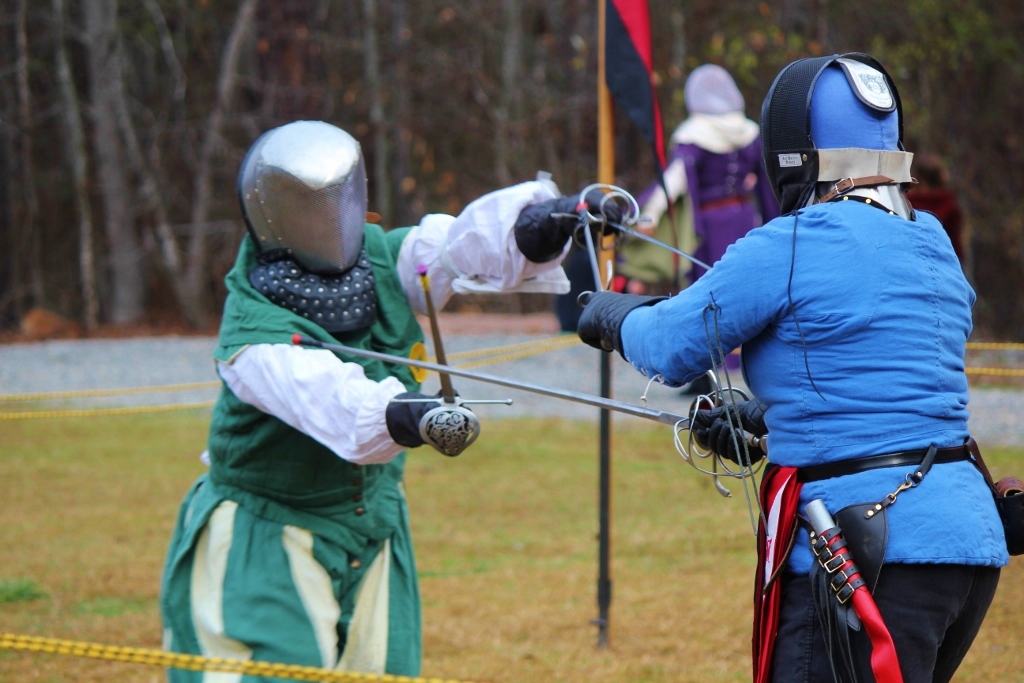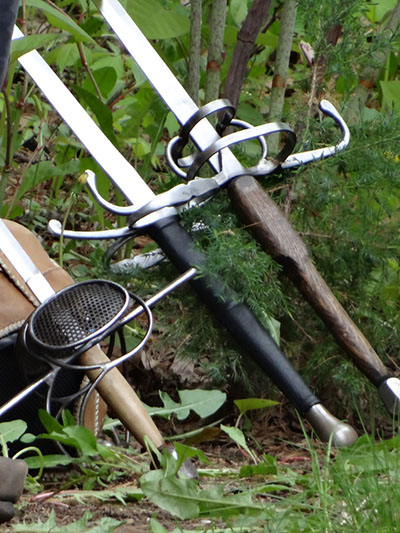Combat Training
Baronial Combat Training includes Armoured Combat, Fencing Combat and Archery. Introductory training is available for anyone 16 years or older.
When: Weekly on Monday nights, from 7 pm to 9 pm
Where: Brisbane Bridge Centre, 104 Frederick St, Annerley (link to map)
Cost: $5 for members, $15 for non-members, first time free for members, $10 for non-members. If it is not your first time, you can prepay via this link. Please note we don’t have EFTPOS or cash options.
Types of combat within the SCA
Within the Society for Creative Anachronism, we have three main forms of combat:
- Armored Combat with various weapons, for Tournaments, Melees and Wars
- Fencing / Rapier Combat
- Archery (Target Archery and Combat Archery)

Each of these have a specific set of rules which ensure that personal safety is considered at all times.
Fighting within the SCA is a full contact sport, and we have special rules governing our weapons, armor and rules of engagement. The most obvious difference between the SCA and other medieval groups is that we do not play with real metal swords. Instead, we use swords made of wood, called rattan. These differences are also noticeable in Light Combat where the arrows we fire at each other have a rubber stopper (we call it a blunt) at the end rather than a metal arrowhead.
Fighting normally occurs under two sets on rules: tournaments and wars.
A tournament is fought upon the list field, where combatants will face each other until there is a victor. This is done with pageantry, chivalry and skill. Tournaments are run fairly often and are fun to watch and to participate in.
Wars occur every couple of months on average across Australia and New Zealand. Wars are big events with people coming from interstate and overseas to take part. It is common in Australia for wars to have 200 people aside. There are wars in the United States that have over two thousand people on each side.
Armored Combat

One of the most well-known and widely-enjoyed activities in the SCA is armored combat. Our warriors participate in tournaments for individuals and teams, tactical melees involving dozens of combatants, and even large-scale wars with thousands of participants! Unlike reenactments of battles from history, our combat activities are unchoreographed and the outcome is entirely based on the skill and training of the combatants involved.
Combat in the Society is based on a system of honor and chivalry. Because the combat is full speed and unchoreographed, the combatants themselves determine if the attacks they receive were successful based on the angle, location, and force of the strike. Safety officers, known as marshals, are always on hand to ensure that the combat is performed safely and to ensure that all equipment used meets established safety standards.
If you would like to know more about armored combat , read more below, or take a look at the Combat Handbook.
Weapons and Armor
The weapons used in our armored combat activities are largely made out of rattan, a grass that looks and feels very much like bamboo but has a solid core. Rattan is a safe alternative to wood for our recreated weapons because if a weapon breaks, it shears along the grass instead of splintering. We also have other types of weapons such as axes and maces that use rubber and foam to create a safe replica of the weapon that looks like the original but is much safer to use.
Our armor is designed to provide covered to important joints and organs so that our combat activities can be both thrilling and safe. Both the Society and the individual kingdoms have a set of minimum standards for this armor, but as a general rule, armored combatants must have sufficient protection for their head and neck, their joints (wrists, elbows, shoulders, and knees), their hands, and their kidneys and groin. Armor can be customized to reflect the period of combat the individual prefers to study, from full suits of armor made of plate metal to shirts of chainmaille links to scales and belts of hardened leather. We also use shields made from wood or metal that help to protect us.

Siege Engineering and Fortification
At our major events, our engineers bring out their ballistae, catapults, and trebuchets and join in the fun! We have both safety-controlled demonstrations of siege weaponry using realistic ammunition and combat siege engineering that uses specially-designed, padded ammunition.
The SCA has several events at large venues that allow us to construct walls, castles, and other fortifications around which we hold combat activities. There are few other opportunities you’ll find to be a real warrior storming a castle in the 21st century!
Archery

One of the most important skills throughout the timeframe that we recreate, archery was used for hunting, practice, and especially war. Archery played an important role in many a battle and many cultures depended upon their innovative and skilled archers for defense as well as a means of conquest.
In the Society, we offer options to participate in both target archery and combat archery!
Target Archery
In order to be as true to times as possible we try to use materials and methods available to period archers. This includes a focus on natural materials such as wood and feathers in our bows and arrows. Some modern types of equipment like compound bows, are not allowed in our archery activities to keep the playing field more level and medieval.
In addition to the traditional target archery competitions where points are scored by shooting at a bullseye, the competitions for target archery are often designed to mimic situations faced by medieval archers. These might include 3-D or 2-D animal targets set at unknown ranges to demonstrate hunting prowess. Alternatively, a set of targets might be made to represent the slots on a fortress, the objective being to try to shoot the “archers” within the walls of a fortification under siege. Novelty targets will sometimes be encountered; blow out a candle with an arrow without hitting the candle itself, hit your target paddle to trip a swinging bar to block your opponent’s paddle from falling before they can shoot it, or get the best poker hand by skill or luck.
Click here if you would like to know more about target archery
Combat Archery

Combat archery is more complicated and challenging than target archery, because your targets are all moving independently – and some of them may be shooting back at you or coming at you with a weapon of their own! Be assured, you will be using low-powered bows and you will be adequately armored, similarly to your opponents. The low power of the bows makes them much safer to use, and the design of the arrows and crossbow bolts ensures maximum safety, while still allowing your armored opponent to know they have been hit. The battle field may be a flat area of grass, ranged across the woods, or even an assault on a fortification, and ranges may be from point blank to as far as you can cast your arrow, all in the name of realism and the chaos of battle as experienced by our ancestors in ages long ago.
Click here if you would like to know more about Combat Archery
Thrown Weapons
In addition to the target competition found in archery, we also recreate additional target weapons styles. At many Society events, you can find opportunities to try throwing common medieval weapons such as axes, knives, and spears, all in a safe, monitored environment.
Fencing

Rapier combat in the Society attempts to recreate styles of swordfighting from the later part of the Middle Ages, often based on manual and theories of combat that have survived to this day. Rapier combat uses a foundation of style and finesse that has since evolved into the modern sport of fencing. Unlike the modern sport, our combat uses a wide variety of weapons and body protection and our combat takes place with freedom of movement in any direction. Rapier combat can be found in both tournaments of individual and team combatants and in larger melees and wars!
Like armored combat, rapier combat in the Society is based on a system of honor and chivalry. Because the combat is full speed and unchoreographed, the combatants themselves determine if the attacks they receive were successful based on the angle, location, and force of the strike. Safety officers, known as marshals, are always on hand to ensure that the combat is performed safely and to ensure that all equipment used meets established safety standards.
Click here if you would like to know more about fencing. or continue reading below.
Weapons and Armor
Weapons used in rapier combat are made out of safe, unsharpened steel capped with rubber and foam safety tips that ensure no actual cutting or puncturing takes place. There are a wide variety of these blades that range from small daggers to large, two-handed great swords. Additional, other implements such as bucklers or small shields, capes, canes, and more can be used to block and parry attacks.
Protective clothing is required for all rapier combatants. This clothing ranges in style and material based on Society and kingdom standards, but in general all combatants wear protection across their whole body, including their head and neck. This may include thick, padded clothing such as coats or gambesons, or more rigid armor such as mail or scale.

Cut and Thrust
In recent years, a new type of combat has undergone development across the Society called “Cut and Thrust” combat. This style of combat could be considered a hybrid of armored and rapier combat that involves more stringent protection standards including more rigid armor than rapier combat but still uses unsharpened steel blades instead of the rattan of armored combat. Cut and Thrust is still in an experimental stage in many kingdoms and may not be available in all.
Text taken from the SCA Newcomers combat pages (welcome.sca.org/armored-combat/, welcome.sca.org/archery/ and welcome.sca.org/rapier-combat/). Photos from Amalia del Bewnino.

